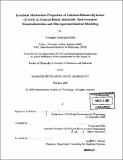Invariant mechanical properties of calcium-silicate-hydrates (C-H-S) in cement-based materials : instrumented nanoindentation and microporomechanical modeling
Author(s)
Constantinides, Georgios, 1978-
DownloadFull printable version (43.81Mb)
Other Contributors
Massachusetts Institute of Technology. Dept. of Civil and Environmental Engineering.
Advisor
Franz-Josef Ulm.
Terms of use
Metadata
Show full item recordAbstract
Random porous solids such as bone and geomaterials exhibit a multiphase composite nature, characterized by water-filled pores of nm- to m-scale diameter. The natural synthesis and operating environments of such materials significantly alters phase composition and multiscale structural heterogeneities throughout the material lifetime, defining significant changes in macroscopic mechanical performance for applications ranging from multispan bridges to calcium-phosphate bone replacement cements. However, the nanoscale phases formed within the unique chemical environment of pores cannot be recapitulated ex situ in bulk form, and imaging of the composite microstructure is obfuscated by the size, environmental fragility, and nonconductive nature of such geomaterials and natural composites. Thus, there is an increasing drive to develop new approaches to image, quantify the mechanical contributions of, and understand the chemomechanical coupling of distinct phases in such composites. In this thesis, we utilize recent advances in experimentation namely instrumented indentation, and micromechanical modeling namely homogenization techniques, in an attempt to quantify the mutli-phase, multi-scale heterogeneity observed in all cement-based materials. We report a systematic framework for mechanically enabled imaging, measuring and modeling of structural evolution for cement based materials (CBM), porous geocomposites, at length scales on the order of constituent phase diameters (10-8 - 10-6 m), and thus identify two structurally distinct but compositionally similar phases heretofore hypothesized to exist. (cont.) The presented experimental and modeling results culminated in micromechanical models for elasticity and strength that can predict the macroscopic mechanical behavior for a range of CBM systems. The models directly correlate the changes in chemical and mechanical state to predict the experimentally observed range of macroscopic mechanical properties. This general framework is equally applicable to other man-made and natural composites, and enables accurate prediction of natural composite microstructure and mechanical performance directly from knowledge of material composition.
Description
Thesis (Ph. D.)--Massachusetts Institute of Technology, Dept. of Civil and Environmental Engineering, 2006. Includes bibliographical references (p. 455-478).
Date issued
2006Department
Massachusetts Institute of Technology. Department of Civil and Environmental EngineeringPublisher
Massachusetts Institute of Technology
Keywords
Civil and Environmental Engineering.